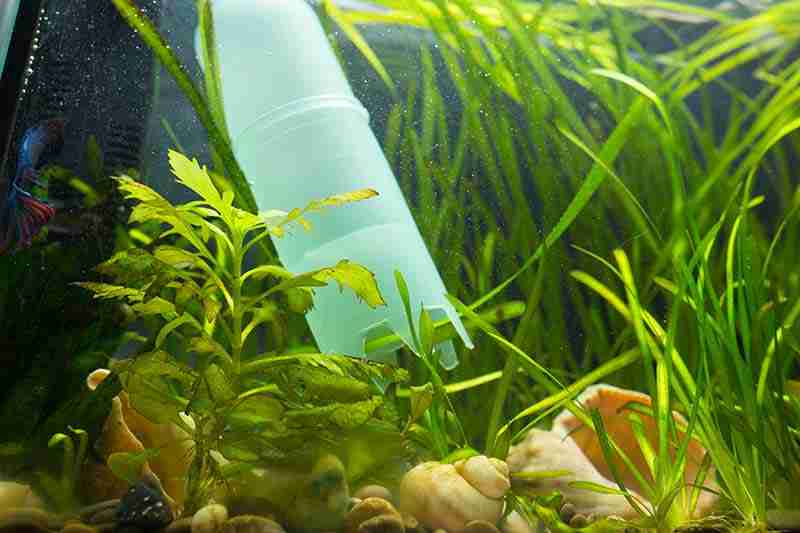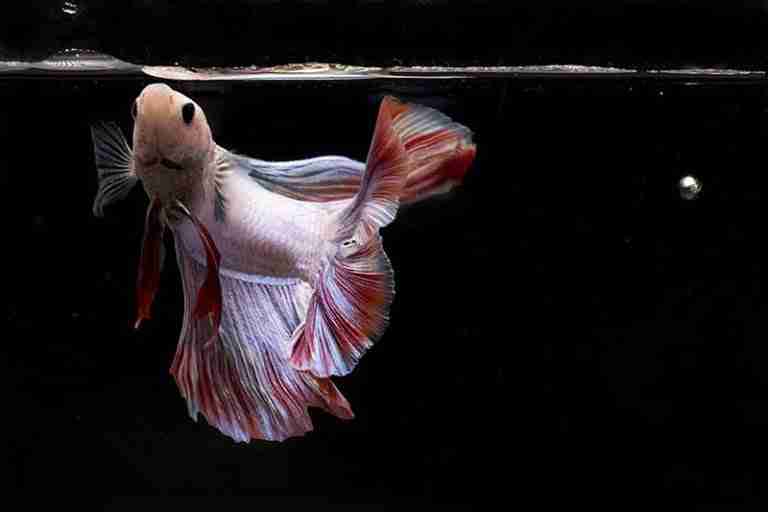How Often Do You Clean a Betta Fish Tank For Optimum Health
You’ve probably heard that you should clean your betta fish tank every week, and some betta owners advise you to clean your tank daily. With so much advice out there, who should you listen to, and what are the facts? How often do you clean a betta fish tank to keep it healthy and waste-free?
A betta fish tank should be cleaned as often as necessary to remove accumulated dirt and debris that has been allowed to build up. Each tank is different, and the cleaning frequency depends on several factors, such as:
- Tank Size – Usually, the bigger the tank, the less often it needs cleaning.
- Does your tank have a filter? – Filters will help to keep a tank cleaner for longer.
- Is your betta tank well planted? – Plants aid in the bioactivity of your tank.
- How bioactive is your aquarium? – The more bioactive, the more it sustains itself.
- How many fish are in your tank? – More fish equates to more waste build-up.
It is recommended that you clean a small betta tank (1-10 gallons) without a filter and plants every few days, with a 20 percent water change. A tank of up to 50 gallons should be cleaned every week with a 20-40 percent water change. The addition of a filter and live plants helps to keep the tank clean for longer, reducing the frequency of water changes.

Each aquarium is different, and the cleaning frequency varies. When it comes to betta fish tank cleaning, how often you do it affects your tank’s overall health. Cleaning your betta tank too often is not necessarily a good thing.
Throughout this article, I explain everything you need to know to determine how often your betta tank needs to be cleaned to keep it healthy and improve your betta’s lifespan.
Make sure to check out our Betta Fish Care Guide.
Betta Tank Cleaning Frequency
This is just a guide, as no definitive rule fits all situations, but the table below can help you with some general guidelines based on how often other aquarists clean their tanks.
| Aquarium Size | Cleaning Frequency Without Filter | Cleaning Frequency With Filter |
|---|---|---|
| 1-5 Gallon | 10-20% Every 2-3 Days | 20% Once A Week |
| 5-10 Gallon | 10-20% Twice a week | 20% Once A Week |
| 10-20 Gallon | Requires A Filter | 25% Every 1-2 Weeks |
| 20-50 Gallon | Requires A Filter | 25% Every 2-3 Weeks 50% Every 8-12 Weeks |
| 50+ Gallon | Requires A Filter | 25% Every 4 Weeks 50% Every 8-12 Weeks |
How Often Do You Clean A Betta Fish Tank – Understanding Your Tank
Understanding your betta tank is important so you know when to clean it. Every tank has its own level of bioactivity, which will determine how often you should clean it- the higher the level of bioactivity in your tank, the less you need to clean.
What Is A Bioactive Fish Tank?
A bioactive fish tank produces a self-sustaining atmosphere/environment, as you would find in nature. You wouldn’t need to change the water or clean the gravel unless the level of bioactivity falls. The only thing to do in a highly bioactive tank is feed the fish.
Bioactivity within a betta tank can be increased by having live plants, adding gravel to your aquarium, and ensuring there are plenty of hiding places for your betta fish. You should also find that a well-cycled bioactive tank has nitrifying bacteria that break down ammonia into nitrogen. If you watch your ammonia levels, you will know how often to clean out the tank.
Gravel is also a good place for beneficial bacteria to grow, where much of the waste becomes trapped.
Fish produce ammonia as a waste product, which can be lethal at high concentrations. Ammonia must be broken down into nitrite and then nitrate before it becomes a harmless nitrogen gas, released into the atmosphere through filters or water changes.
When you have a bioactive tank full of natural, beneficial bacteria, your ammonia levels should never rise above 0.25 ppm (parts per million). If this level is reached, you need to clean out the tank so that the nitrifying bacteria can disperse into other parts of your aquarium again, i.e., gravel, filter, etc.
Nitrate is the final product of the nitrogen cycle, and although less toxic, it can rise above safe levels for fish, especially if your tank becomes too dirty or overpopulated. If nitrate levels get too high, you will need more frequent water changes to drop down again into a safe range.

Beneficial Bacteria
A highly bioactive fish tank will contain high levels of beneficial bacteria, which:
- Fight off bad bacteria.
- Eat up leftover fish food and other waste.
- Help to keep your tank clean by breaking down waste material and turning it into nutrients for plants or algae.
- Help to reduce levels of ammonia, nitrates, and nitrites, increasing dissolved oxygen levels within the water.
Plants
Live plants are also common to see in very bioactive fish tanks and help by:
- Enhancing oxygen levels.
- Enhancing water quality by helping to absorb ammonia and nitrates.
- Reducing the toxic load of an aquarium with its root systems effectively absorbing ammonium from fish waste.
- Live plants also provide a hiding place for your betta while increasing the surface area available for good bacteria growth within your tank, making it even more bioactive.
Live aquarium plants need regular cleaning to remove algae buildup and snails so that they will remain healthy.
Lighting
Lighting is essential if you want a bioactive tank. Fish have their own circadian rhythm and require night and day to keep their bodies ticking over smoothly.
Plants also require light for photosynthesizing during the day to produce oxygen. During the night, plants produce carbon dioxide. It all adds up to creating your own bioactive environment.
Getting a completely self-sustaining betta tank is challenging because you would have to emulate the natural conditions perfectly. Still, the more bioactive your tank, the less often you need to clean it.
A new tank may take many months before it reaches a good level of bioactivity.
Using A Filter
Many inexperienced betta owners will keep their betta in a tank that is far too small and not fit for purpose, not only because they won’t provide enough room to swim but also because small tanks don’t usually have room for a filter, making it hard to maintain the ideal betta water parameters. So do bettas need a filter?
Using a filter in your betta tank is beneficial for many reasons, even though betta fish don’t actually need a filter. If we have a quick look at what a filter will do for your betta tank, you will have a better understanding of its benefits:
- Filters will keep your betta fish safe from water-borne diseases. They will also help to reduce stress by removing toxins such as ammonia and nitrite, which are harmful to your bettas.
- Filters remove solid waste material using mechanical filtration i.e. – they strain it out of the tank; this is an extremely important part of keeping a clean tank.
- Filters also provide oxygen to the betta fish because they constantly move water around, aiding gas exchange at the surface of your aquarium where there is more dissolved oxygen. This will keep your betta very happy.
So having a filter in place will definitely reduce the frequency of your tank cleaning.
Tank Heating
Betta fish are a tropical species, so a warm water temperature will be necessary. Ensuring that your betta’s water temperature is at its optimal (78-82°F/26-28°C) will help your betta’s natural biological functions and general health remain at their best.
Having the right temperature will also help all the bacteria in the water to thrive, especially the good bacteria. If the temperature is set too high, it will kill many forms of bacteria, parasites, and diseases, which is helpful if your betta can tolerate it.

You will need a tank thermometer to monitor the temperature and ensure consistency. Betta fish are good at tolerating temperatures outside their usual range, provided it doesn’t fluctuate too much.
Warm temperatures are also good for plant life, but algae will be encouraged to grow if temperatures are too warm for too long.
Don’t Overfeed Your Betta Fish
Overfeeding your betta is often to blame for excessive cleaning of your betta’s tank. Too much food will become waste and get in the aquarium gravel, where it will rot, causing a rise in ammonia and nitrite to toxic levels. At this stage, you will need more frequent water changes so that they drop down again into a safe range.
A highly bioactive fish tank will contain high levels of beneficial bacteria, which will help to eat up leftover fish food and other debris, but the bacteria will not manage this alone. Overfeeding does not happen in a betta’s natural habitat, and it shouldn’t happen in captivity.
I have a complete guide on how often to feed betta fish.
So How Often Do I Clean My Betta Tank?
With everything I have said, it kind of throws a spanner in the works and makes it difficult to give an ideal timeframe for cleaning a betta tank based on its size.
To be helpful, I have included a table at the top of this post with general guidelines for average tanks only.
All figures I have mentioned are guidelines and estimations. As I have mentioned, each betta fish tank is different, and by testing the water quality in your tank regularly, you will know how often it will need to be cleaned.
There are always exceptions to the rule, and water changes may be necessary more frequently, especially if oxygen levels drop significantly or disease is present in the tank, but if your tank is very bioactive, you may not need to clean it very often.
If you own a smaller aquarium, planting it and adding a filter may not be possible, so you will not get the level of bioactivity you require. A smaller body of water will also be susceptible to sudden changes in temperature and chemistry and will need frequent cleaning.
There are complete water testing kits available for every scenario. You can test water pH levels, test for chlorine and other chemicals, and test the oxygen content in the water.

If your tank is stable and you are not overfeeding, you will know that when these levels begin to fall outside the optimum ranges, or if your tank looks dirty, it will need to be cleaned. If you are fortunate, these intervals will remain consistent.
How To Clean A Betta Fish Tank
This article is not to explain the process of how to clean a betta fish tank, but as cleaning is part of what I am covering, I will quickly walk you through the betta fish tank cleaning process.
- Clean your betta tank thoroughly, including the tank glass, with a clean sponge or cloth, inside and out. Don’t use any household cleaning chemicals, as they will poison your fish.
- Remove ornaments that can be rinsed with tap water, and clean fish tank decorations thoroughly.
- Use a gravel vacuum to siphon through the gravel substrate, removing plant waste, uneaten food, and fish waste. Compare Prices For Gravel Vacuums.
- Using the tank cleaning siphon, remove up to half the tank water into a clean bucket.
- Clean the filter media by rinsing under tap water, and if using a sponge filter, ensure you submerge in the old dirty water before returning to the tank. It is full of beneficial bacteria, and this will ensure the bacteria reinhabits the filter sponges before being returned.
- Discard the old water and fill the bucket with clean tap water or bottled drinking water.
- Add warm water to match it to the water in the aquarium, and add a suitable water conditioner. Find The Best Price For API Tap Water Conditioner. Unconditioned tap water will contain chlorine and other chemicals harmful to your betta aquarium.
- Add the replacement water slowly to the tank. Add half the water, then the remaining water to not unsettle your betta too much.
- Clean the tank glass of any splashes with a paper towel to avoid streaking.
There you go! Your betta fish water should be much cleaner, and by doing smaller water changes, you won’t lose all that lovely beneficial bacteria you have worked so hard to get.
Below is a really good 5-minute video guide that I found detailing how to clean a betta fish tank.
Learning how to clean a betta tank correctly is important for the long-term health of your fish, so it would be wise to check out an article I wrote on how often to change betta water, which provides further information on cleaning a betta tank.
If you find that you have hard water stains that are difficult to remove or a build-up of calcium deposits, you can consider using a vinegar solution.

You can remove your betta into a temporary container if you are doing a larger water change or just prefer to. You will need to gently scoop him out with a net.
How To Keep A Betta Fish Tank Clean
Now that you know how to clean a betta fish tank, the next question I will expect you to ask is, how to keep a betta fish tank clean?
Keeping your betta tank clean is a simple case of developing a regular schedule. You can do this by visually checking your tank’s cleanliness and water parameters. If you notice fluctuations or big changes away from the ideal betta water parameters, then you know that your tank will need cleaning.
If you maintain a regular feeding regime, the waste build-up in your tank should be consistent, so you will know whether weekly or bi-weekly water changes will be best. Don’t overdo the frequency of your water changes, as it can remove the beneficial bacteria that are present in your betta’s tank.
If you are using a filter, it will help to keep waste to a minimum and help to keep your betta fish tank clean for longer.
Conclusion
Hopefully, you have found this post helpful and informative. If you have taken away anything, I hope you understand that what you read or are told are just basic guidelines that apply to most tank setups.
Each tank has its own biological cycle, which depends on many factors working together, so you should gauge how regularly your tank needs to be cleaned with a little testing and consistency with feeding.
If you have a very bioactive tank, you are lucky and definitely doing things right. As your reward, tank cleaning may only be required once every 3-4 weeks; otherwise, you may find you will be cleaning it twice a week.







